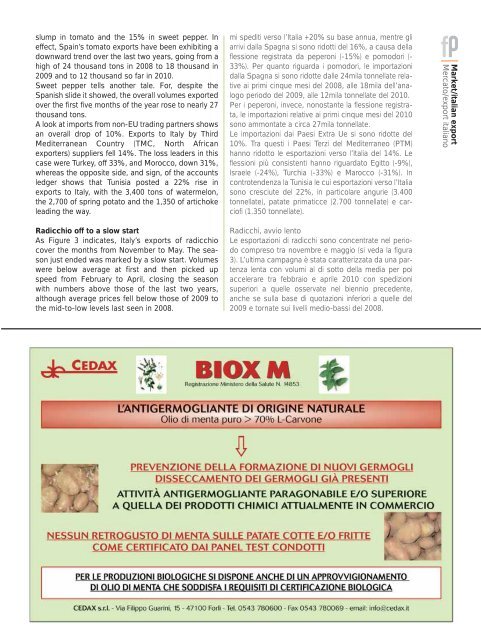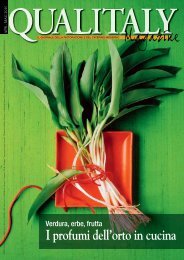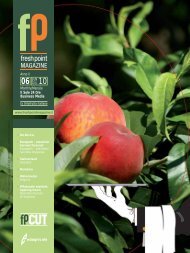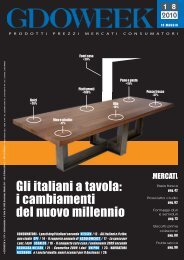Fresh Point Magazine - B2B24 - Il Sole 24 Ore
Fresh Point Magazine - B2B24 - Il Sole 24 Ore
Fresh Point Magazine - B2B24 - Il Sole 24 Ore
You also want an ePaper? Increase the reach of your titles
YUMPU automatically turns print PDFs into web optimized ePapers that Google loves.
slump in tomato and the 15% in sweet pepper. In<br />
effect, Spain’s tomato exports have been exhibiting a<br />
downward trend over the last two years, going from a<br />
high of <strong>24</strong> thousand tons in 2008 to 18 thousand in<br />
2009 and to 12 thousand so far in 2010.<br />
Sweet pepper tells another tale. For, despite the<br />
Spanish slide it showed, the overall volumes exported<br />
over the first five months of the year rose to nearly 27<br />
thousand tons.<br />
A look at imports from non-EU trading partners shows<br />
an overall drop of 10%. Exports to Italy by Third<br />
Mediterranean Country (TMC, North African<br />
exporters) suppliers fell 14%. The loss leaders in this<br />
case were Turkey, off 33%, and Morocco, down 31%,<br />
whereas the opposite side, and sign, of the accounts<br />
ledger shows that Tunisia posted a 22% rise in<br />
exports to Italy, with the 3,400 tons of watermelon,<br />
the 2,700 of spring potato and the 1,350 of artichoke<br />
leading the way.<br />
Radicchio off to a slow start<br />
As Figure 3 indicates, Italy’s exports of radicchio<br />
cover the months from November to May. The season<br />
just ended was marked by a slow start. Volumes<br />
were below average at first and then picked up<br />
speed from February to April, closing the season<br />
with numbers above those of the last two years,<br />
although average prices fell below those of 2009 to<br />
the mid-to-low levels last seen in 2008.<br />
mi spediti verso l’Italia +20% su base annua, mentre gli<br />
arrivi dalla Spagna si sono ridotti del 16%, a causa della<br />
flessione registrata da peperoni (-15%) e pomodori (-<br />
33%). Per quanto riguarda i pomodori, le importazioni<br />
dalla Spagna si sono ridotte dalle <strong>24</strong>mila tonnellate relative<br />
ai primi cinque mesi del 2008, alle 18mila dell’analogo<br />
periodo del 2009, alle 12mila tonnellate del 2010.<br />
Per i peperoni, invece, nonostante la flessione registrata,<br />
le importazioni relative ai primi cinque mesi del 2010<br />
sono ammontate a circa 27mila tonnellate.<br />
Le importazioni dai Paesi Extra Ue si sono ridotte del<br />
10%. Tra questi i Paesi Terzi del Mediterraneo (PTM)<br />
hanno ridotto le esportazioni verso l’Italia del 14%. Le<br />
flessioni più consistenti hanno riguardato Egitto (-9%),<br />
Israele (-<strong>24</strong>%), Turchia (-33%) e Marocco (-31%). In<br />
controtendenza la Tunisia le cui esportazioni verso l’Italia<br />
sono cresciute del 22%, in particolare angurie (3.400<br />
tonnellate), patate primaticce (2.700 tonnellate) e carciofi<br />
(1.350 tonnellate).<br />
Radicchi, avvio lento<br />
Le esportazioni di radicchi sono concentrate nel periodo<br />
compreso tra novembre e maggio (si veda la figura<br />
3). L’ultima campagna è stata caratterizzata da una partenza<br />
lenta con volumi al di sotto della media per poi<br />
accelerare tra febbraio e aprile 2010 con spedizioni<br />
superiori a quelle osservate nel biennio precedente,<br />
anche se sulla base di quotazioni inferiori a quelle del<br />
2009 e tornate sui livelli medio-bassi del 2008.<br />
Market/italian export<br />
Mercato/export italiano
















